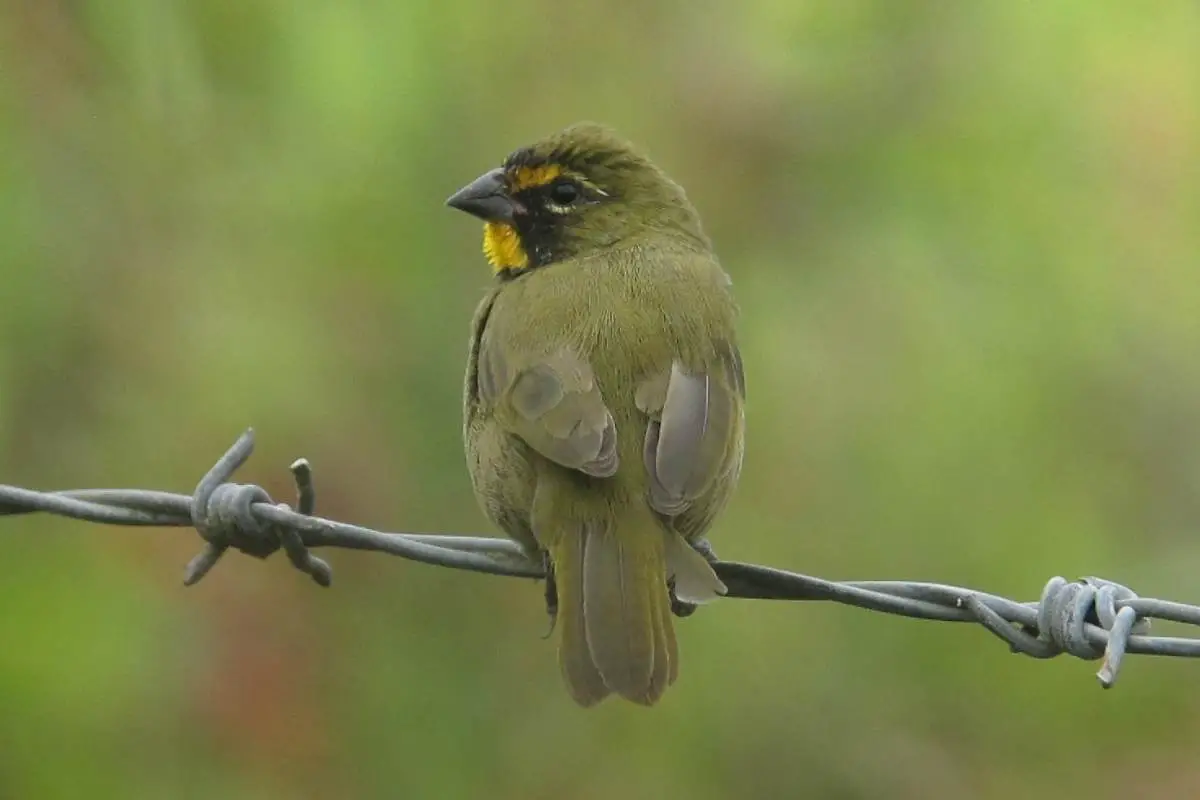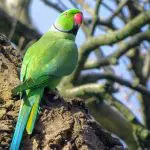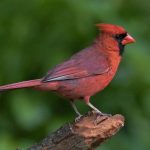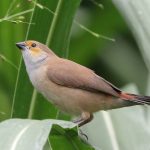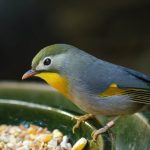Yellow-faced grassquit on barbed wire | image by Félix Uribe via Flickr | CC BY-SA 2.0
Yellow-faced Grassquit (Tiaris olivaceus) are known for their distinctive yellow faces and olive-green bodies, with males sporting a bright red breast during breeding season. The Yellow-faced Grassquit can be found in a variety of habitats, including forests, grasslands, and gardens.
They are known for their energetic and acrobatic behavior, often seen flitting from branch to branch in search of insects and seeds. In addition to their striking appearance, these birds are also known for their beautiful songs, which they use to communicate with each other and attract mates. If you’re lucky, you may spot a Yellow-faced Grassquit on your next trip to Hawaii!
Common Name: Yellow-faced Grassquit
Scientific Name: Tiaris olivaceus| Size | Diet | Range in Hawaii | Status in Hawaii |
|---|---|---|---|
| 4.5 in. | grasses, berries, small fruits, insects and nectar | Big Islands | least concern |
Yellow-faced Grassquit
Appearance
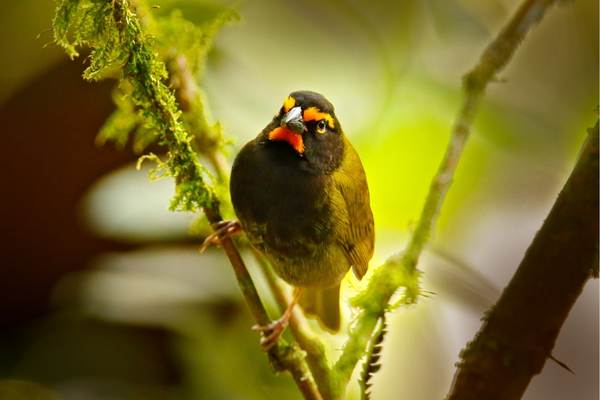
The yellow-faced grassquit is a small, sparrow-like bird with a brightly colored appearance. It has a yellow face and breast, with a brown back and wings.
The wings and tail are relatively short, and the bird has a conical bill that it uses to feed on seeds and insects. The yellow-faced grassquit is about the size of a house sparrow, measuring about 4.5 inches in length and weighing about 0.5 ounces. Its overall coloration is rather subdued, with a mix of brown, yellow, and olive green tones, but its bright yellow face and breast make it quite distinctive.
Diet
The Yellow-faced Grassquit is an omnivorous bird, meaning that it feeds on both plants and animals. Their diet consists primarily of insects, including beetles, grasshoppers, and ants, as well as seeds and fruit.
They have been known to forage for food on the ground, as well as in trees and shrubs. In addition to foraging for food in their natural habitat, Yellow-faced Grassquits may also visit bird feeders and gardens in search of food. They have a particular fondness for nectar, and have been known to visit flowering plants and feeders to obtain this sweet treat.
Behavior
The Yellow-faced Grassquit is a small, active bird with a lively and energetic personality. These birds are known for their acrobatic behavior, often seen flitting from branch to branch or hopping along the ground in search of food. They are social birds and can often be seen in small flocks, although they may also be found alone or in pairs.
During breeding season, males may perform elaborate courtship displays to attract females, including singing and displaying their brightly colored breast feathers. Yellow-faced Grassquits are also known for their beautiful songs, which they use to communicate with each other and to establish their territory. In addition to their vocalizations, these birds also use body language and physical gestures to communicate with each other.
Nesting
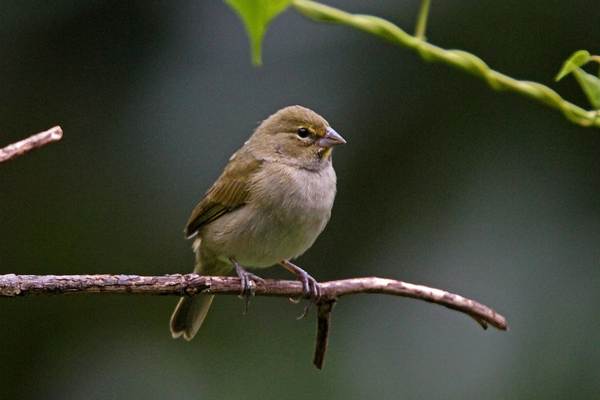
Yellow-faced Grassquits are known to build nests in a variety of locations, including trees, bushes, and even in the crevices of rocks and walls. These nests are typically small and cup-shaped, and are made from grasses, moss, and other plant materials. The female Yellow-faced Grassquit is responsible for building the nest and incubating the eggs, while the male may help to gather materials and defend the nest from predators.
Once the eggs are laid, the female will incubate them for about two weeks until they hatch. Both parents take turns feeding the chicks, which fledge (leave the nest) at around two weeks of age. Yellow-faced Grassquits typically produce one or two broods per year, although this can vary depending on the availability of food and other environmental factors.
Habitat
These birds are adaptable and can be found in a variety of habitats, including forests, grasslands, gardens, and urban areas.
Range
The Yellow-faced Grassquit is a native bird of the Hawaiian Islands, where it can be found on most of the main islands, including Kauai, Oahu, Molokai, Lanai, Maui, and Hawaii.
Conservation Status
The Yellow-faced Grassquit is not considered a threatened or endangered species, and is considered to be of “Least Concern” by the International Union for Conservation of Nature (IUCN). This means that the species is abundant and widespread, and is not currently at risk of extinction.
However, like all wildlife, the Yellow-faced Grassquit is vulnerable to habitat loss and degradation, which can impact their populations. In Hawaii, habitat loss is a major threat to many native species, including birds, as the islands have a high rate of development and urbanization.
Interesting Facts
1. Opportunistic breeders
Yellow-faced Grassquits are opportunistic breeders, meaning that they will breed whenever food resources are abundant. As a result, they may have multiple broods per year.
2. Socially Monogamous
They are socially monogamous, meaning that they form pair bonds with a single mate and mate for life. However, they may engage in extra-pair copulations with other birds.
3. They are territorial
Yellow-faced Grassquits are known to be territorial, and will aggressively defend their territories from intruders, including other Yellow-faced Grassquits and even larger birds.
4. Known for their distinctive, whistled songs
These birds are known for their distinctive, whistled songs, which they use to attract mates and defend their territories.
FREQUENTLY ASKED QUESTIONS:
Are Yellow-faced Grassquits endangered?
The Yellow-faced Grassquit is not currently considered endangered, although it is listed as a species of “Least Concern” on the International Union for Conservation of Nature (IUCN) Red List. However, like many bird species, it may be at risk due to habitat loss and other human activities.
Do Yellow-faced Grassquits migrate?
Yellow-faced Grassquits are non-migratory birds, meaning they do not migrate long distances. However, they may make short-distance movements within their range in response to changes in food availability or weather conditions.
